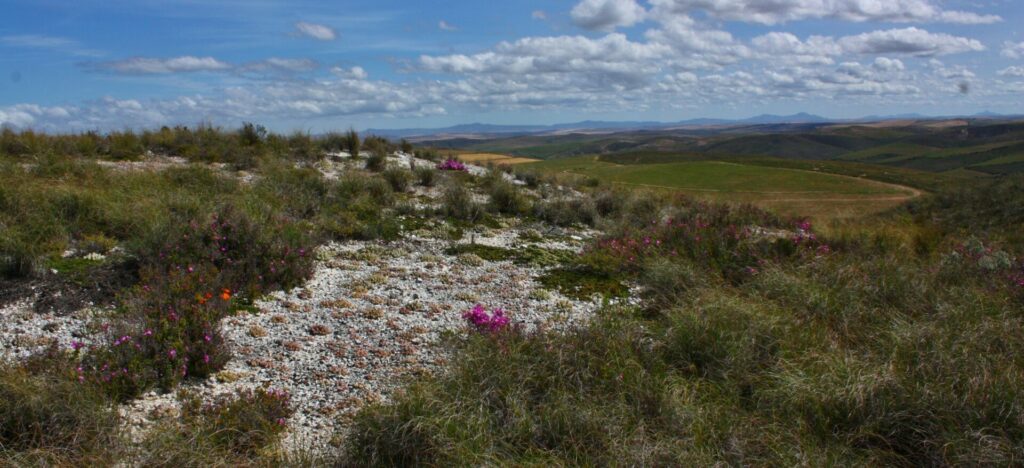An influential partnership between international conservation organisations and the Overberg Renosterveld Conservation Trust (ORCT) has secured the protection of 500 hectares of globally important, Endangered renosterveld in the Overberg. This will provide a lifeline for countless species that would otherwise be at risk of vanishing forever.
This conservation team has collaborated to buy a key portion of property situated 40km south of the town of Swellendam, called Plaatjieskraal. The farm borders the existing 500-hectare Haarwegskloof Renosterveld Reserve. Together, they now make up the largest area of protected renosterveld and the largest cluster of connected renosterveld left on earth.
The partners who teamed up to buy Plaatjieskraal are the ORCT, World Wide Fund for Nature (WWF) South Africa, WLT, the IUCN NL Land Acquisition Fund, as well as USA-based WildLandscapes International. The property will be managed by the ORCT, in partnership with WWF South Africa and the World Land Trust.
The Overberg’s renosterveld clusters are a tapestry of, irises, lillies, orchids, and succulents, such as this Endangered Drosanthemum quadratum. Credit: ORCT
16 years later…
According to Dr Odette Curtis-Scott, Director of the ORCT, “This is a powerful collaboration of like-minded organisations from across the world. This is significant because it shows that renosterveld is, at last, being recognised internationally. It’s really exciting for us to be working with these incredible partners.”
The negotiations to secure the Plaatjieskraal property took 16 years, until a deal was finally reached with the landowner in 2023. She says the acquisition is essential because the farm is home to nearly 500 hectares of intact renosterveld. In contrast, around three quarters of remaining renosterveld are less than one hectare in size – the equivalent of one rugby field.
“Together, we now have nearly 1000 hectares of renosterveld on Plaatjieskraal and Haarwegskloof that have really been given a lifeline,” Odette says. Haarwegskloof was bought by WWF South Africa in 2013, and is managed by the ORCT. Plaatjieskraal will be declared a Nature Reserve and managed together with Haarwegskloof.
Renosterveld is a vital habitat for Critically Endangered plants, endemic birds, antelope, small mammals, predators, and pollinators, yet only 5% of the Overberg’s veld still remains. Credit: ORCT
Home to more than 500 plant species
While the habitat is highly threatened, it nevertheless houses extraordinary levels of plant diversity. Over 560 plant species (and counting!) have been recorded to date, nearly 10% of which are of conservation concern. The high proportion of endemic and threatened species are due to the quartz crystal outcrops, found only in renosterveld patches within this small part of the Overberg. They provide unique micro-habitats on which specialised flora have evolved.
For World Land Trust, this project represents an exciting first, in that it focuses primarily on plant diversity. The area is a botanical hotspot with species new to science still being discovered. For example, the tiny pink iris, Hesperantha kiaratayloriae, was discovered by the ORCT on Plaatjieskraal in 2012. Since then, it has only been found on a single additional (unprotected) property, making it Critically Endangered. This species stands out within its genus, as it is pollinated solely by a single butterfly species.
Similarly, the legume known as Xiphotheca rosemarinifolia was also first collected on Plaatjieskraal and known from just one other (unprotected) property. The delicate iris, Hesperantha muirii and the striking succulent Drosanthemum lavisii, both listed as Endangered, are just some of the botanical jewels that thrive on this special site. Many animals rely on it for their persistence too, including locally rare species like Aardwolf and Aardvark, Honey Badger, several small antelope and predators, and many endemic birds.
The vibrant Endangered Drosanthemum lavisii is just one of the hundreds of plant species found in renosterveld, with countless more waiting to be discovered. Credit: ORCT
A hotspot for breeding Black Harriers
The Haarwegskloof/Plaatjieskraal cluster also supports one of the largest breeding hotspots for the Black Harrier. This endemic, Endangered species relies on large, natural, intact habitats in which to breed. There are only an estimated 1300 individuals left of this charismatic raptor.
This was one of the reasons that the IUCN NL Land Acquisition Fund became involved. According to Marc Hoogeslag, coordinator of the Fund, “As the Land Acquisition Fund of IUCN NL, we did not only look at protecting the habitat of renosterveld’s charismatic animal species, but also took the fauna in this botanically unique region into account.”
Odette explains the dream is to connect all the remaining large remnants together up to the De Hoop Nature Reserve, a coastal fynbos nature reserve managed by South African conservation authority, CapeNature. This could be achieved through buying land from farmers who are willing to sell portions of unused natural vegetation. It could also be done through working with farmers who love their veld to sign conservation easements committing their land to conservation in perpetuity through a voluntary title deed restriction.
The protected land is vital for the golden-eyed, Endangered Black Harriers, who will only breed in undamaged renosterveld. Credit: ORCT
Reaching the landscape dream
She says, “The purchase of Plaatjieskraal’s renosterveld is the culmination of 16 years of persistence and the forming of incredible partnerships. Conservation on the ground is a tough and challenging place to be and we have once again been reminded that persistence, eventually, pays. We are now one step closer to our dream of a contiguous renosterveld reserve that ultimately connects to a coastal fynbos reserve.
“Much remains at stake, and we will not stop here. If we want to preserve this biodiversity hotspot and all its extraordinary hidden jewels, we need to conserve this system in its entirety, conserving its species and the crucial ecological processes that keep the system alive. This broader landscape approach to conservation is our only chance of building resilience in these severely threatened environments, particularly towards the anticipated changes to our climate.”

